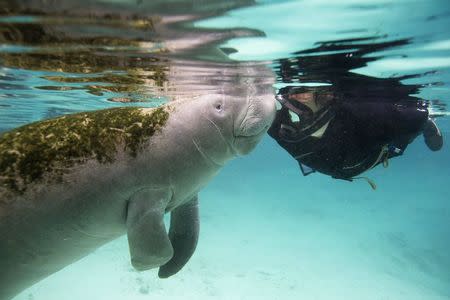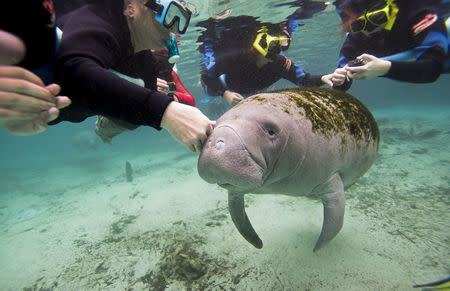Florida manatee population shows signs of recovery, maybe
By Barbara Liston ORLANDO, Fla. (Reuters) - A record 6,063 manatees were sighted in Florida's coastal waters during February's annual headcount, demonstrating the success of conservation efforts for the slow-moving sea cow which once numbered in the hundreds, state wildlife experts said on Tuesday. But advocates for the endangered manatee cautioned that near-perfect conditions for the headcount may have helped push the number higher than ever, said Holly Edwards, a biologist for the Florida Fish and Wildlife Conservation Commission. She added that the number by itself doesn't determine the need for continued federal protections. "The need is not based on numbers of manatees. It's based on whether the threats to manatees have been adequately addressed," Edwards said. Patrick Rose, executive director of the Save the Manatee Club, said the fact that virtually all manatees in Florida have scars from encounters with boats demonstrates the need for protection. Manatees have been on the U.S. Endangered Species list since it was created in 1973. Hunting decimated the population a century ago, Rose said. One environmental group last week filed notice it plans to sue federal wildlife officials on charges of violating the Endangered Species Act, for failing to properly protect manatees. The Public Employees for Environmental Responsibility wants to ban so-called "swim-with" tours that attract swimmers to shallow warm-water lagoons to pet resting manatees. The U.S. Fish and Wildlife Service in February announced rules to restrict swimmers, canoes and kayaks in certain springs where manatees retreat during cold weather to protect the mammals from bumps and injuries. The new count is about 1,000 manatees more than the previous record set in 2010, Edwards said. It comes two years after more than 800 manatees were killed in 2013 due to red tide on the state's west coast, an undetermined pathogen on the east coast, and a lethal cold snap. Rose said the count was made on a day that was clear and sunny on both coasts, illuminating dark water which can obscure the presence of the marine mammals. Edwards said a period of cold weather which encouraged more manatees to congregate in springs and around the warm waters next to power plants followed by a warm snap brought them to the surface where they were easily photographed in aerial surveys. The weather was in sharp contrast to the winter of 2012 and 2013 when conditions were so poor that no count was attempted. "These are not population counts. They're minimum counts," Rose said. (Editing by David Adams and Sandra Maler)


